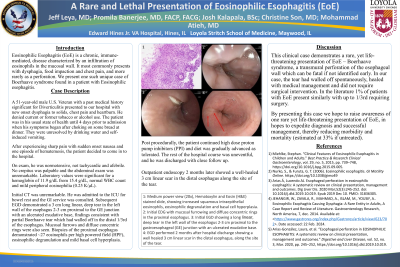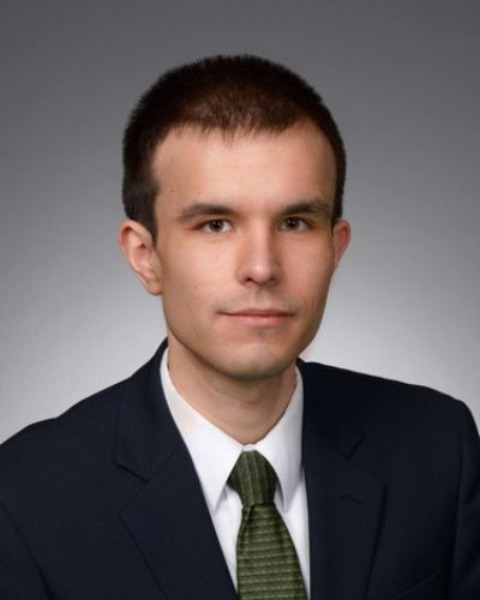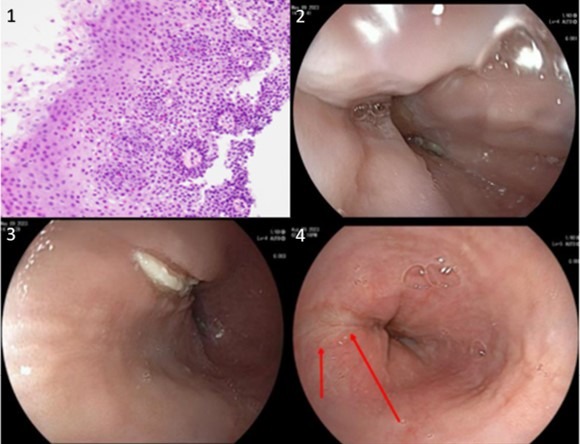Sunday Poster Session
Category: Esophagus
P0573 - A Rare and Lethal Presentation of EoE
Sunday, October 27, 2024
3:30 PM - 7:00 PM ET
Location: Exhibit Hall E

Has Audio

Jeffrey Leya, MD
Edward Hines Jr. Veterans Affairs Hospital
Maywood, IL
Presenting Author(s)
Jeff Leya, MD1, Promila Banerjee, MD, FACG2, Josh Kalapala, BSc3, Christine Son, MD4, Mohammed Atieh, MD1
1Edward Hines Jr. Veterans Affairs Hospital, Maywood, IL; 2Edward Hines Jr. Veterans Affairs Hospital, Loyola University Chicago Stritch School of Medicine, Maywood, IL; 3Edwards Hines Jr. VA Hospital, Maywood, IL; 4Loyola University Medical Center, Maywood, IL
Introduction: Eosinophilic Esophagitis (EoE) is a condition defined as a chronic, immune-mediated, esophageal disease characterized by symptoms of esophageal dysfunction. EoE most commonly presents with dysphagia, food impaction, chest pain and rarely with an esophageal perforation. We present a unique case of a patient who presents with Boerhaave syndrome in the setting of undiagnosed EoE.
Case Description/Methods: A 51-year old male U.S. Veteran with a past medical history significant for Diverticulitis who presented to our hospital with new onset dysphagia to solids, chest pain and heartburn. He was in his usual state of health until 4 days prior when he developed these symptoms after choking on bread at dinner. Symptoms were unresolved by drinking water and self-induced vomiting. On exam, the patient was normotensive, not tachycardic and afebrile. The abdominal exam was benign. No crepitus was palpable. Laboratory values significant for a hemoglobin of 11.9 g/dL from 15.4 g/dL, normal WBC count and mild peripheral eosinophilia (0.25 K/μL).
Initial CT was unremarkable. He was admitted to the ICU for bowel rest. GI was consulted and subsequent EGD demonstrated a 3 cm long linear, deep tear in the left wall of the esophagus 2-3 cm proximal to the GE junction with an ulcerated exudative base, findings consistent with partial Boerhaave tear which had walled off in the distal 1/3rd of the esophagus. Mucosal furrows and diffuse concentric rings were also seen. Biopsies demonstrated ~27 eosinophils per high powered field (HPF), eosinophilic degranulation and mild basal cell hyperplasia. Post procedurally, the patient continued high dose proton pump inhibitors (PPI) and diet was gradually advanced as tolerated. The rest of the hospital course was uneventful, and he was discharged with close follow up.
Outpatient endoscopy 2 months later showed a well-healed 3 cm linear scar in the distal esophagus along the site of the tear.
Discussion: This clinical case demonstrates a rare, yet life-threatening presentation of EoE – Boerhaave syndrome, a transmural perforation of the esophageal wall which can be fatal if not identified early. In our case, the tear walled off spontaneously without surgical intervention. In the literature 1% of patients present similarly with upto 1/3rd requiring surgery. We hope to raise awareness of this rare yet life-threatening presentation of EoE, in hopes to expedite diagnosis and successful management, thereby reducing morbidity and mortality (estimated at 33% if untreated).

Disclosures:
Jeff Leya, MD1, Promila Banerjee, MD, FACG2, Josh Kalapala, BSc3, Christine Son, MD4, Mohammed Atieh, MD1. P0573 - A Rare and Lethal Presentation of EoE, ACG 2024 Annual Scientific Meeting Abstracts. Philadelphia, PA: American College of Gastroenterology.
1Edward Hines Jr. Veterans Affairs Hospital, Maywood, IL; 2Edward Hines Jr. Veterans Affairs Hospital, Loyola University Chicago Stritch School of Medicine, Maywood, IL; 3Edwards Hines Jr. VA Hospital, Maywood, IL; 4Loyola University Medical Center, Maywood, IL
Introduction: Eosinophilic Esophagitis (EoE) is a condition defined as a chronic, immune-mediated, esophageal disease characterized by symptoms of esophageal dysfunction. EoE most commonly presents with dysphagia, food impaction, chest pain and rarely with an esophageal perforation. We present a unique case of a patient who presents with Boerhaave syndrome in the setting of undiagnosed EoE.
Case Description/Methods: A 51-year old male U.S. Veteran with a past medical history significant for Diverticulitis who presented to our hospital with new onset dysphagia to solids, chest pain and heartburn. He was in his usual state of health until 4 days prior when he developed these symptoms after choking on bread at dinner. Symptoms were unresolved by drinking water and self-induced vomiting. On exam, the patient was normotensive, not tachycardic and afebrile. The abdominal exam was benign. No crepitus was palpable. Laboratory values significant for a hemoglobin of 11.9 g/dL from 15.4 g/dL, normal WBC count and mild peripheral eosinophilia (0.25 K/μL).
Initial CT was unremarkable. He was admitted to the ICU for bowel rest. GI was consulted and subsequent EGD demonstrated a 3 cm long linear, deep tear in the left wall of the esophagus 2-3 cm proximal to the GE junction with an ulcerated exudative base, findings consistent with partial Boerhaave tear which had walled off in the distal 1/3rd of the esophagus. Mucosal furrows and diffuse concentric rings were also seen. Biopsies demonstrated ~27 eosinophils per high powered field (HPF), eosinophilic degranulation and mild basal cell hyperplasia. Post procedurally, the patient continued high dose proton pump inhibitors (PPI) and diet was gradually advanced as tolerated. The rest of the hospital course was uneventful, and he was discharged with close follow up.
Outpatient endoscopy 2 months later showed a well-healed 3 cm linear scar in the distal esophagus along the site of the tear.
Discussion: This clinical case demonstrates a rare, yet life-threatening presentation of EoE – Boerhaave syndrome, a transmural perforation of the esophageal wall which can be fatal if not identified early. In our case, the tear walled off spontaneously without surgical intervention. In the literature 1% of patients present similarly with upto 1/3rd requiring surgery. We hope to raise awareness of this rare yet life-threatening presentation of EoE, in hopes to expedite diagnosis and successful management, thereby reducing morbidity and mortality (estimated at 33% if untreated).

Figure: 1: Medium power view (20x), Hematoxylin and Eosin (H&E) stained slide, showing increased squamous intraepithelial eosinophils, eosinophilic degranulation and basal cell hyperplasia.
2: Initial EDG with mucosal furrowing and diffuse concentric rings in the proximal esophagus.
3: Initial EGD showing a long linear, deep tear in the left wall of the esophagus 2-3 cm proximal to the gastroesophageal (GE) junction with an ulcerated exudative base.
4: EGD performed 2 months after hospital discharge showing a well healed 3 cm linear scar in the distal esophagus, along the site of the tear.
2: Initial EDG with mucosal furrowing and diffuse concentric rings in the proximal esophagus.
3: Initial EGD showing a long linear, deep tear in the left wall of the esophagus 2-3 cm proximal to the gastroesophageal (GE) junction with an ulcerated exudative base.
4: EGD performed 2 months after hospital discharge showing a well healed 3 cm linear scar in the distal esophagus, along the site of the tear.
Disclosures:
Jeff Leya indicated no relevant financial relationships.
Promila Banerjee indicated no relevant financial relationships.
Josh Kalapala indicated no relevant financial relationships.
Christine Son indicated no relevant financial relationships.
Mohammed Atieh indicated no relevant financial relationships.
Jeff Leya, MD1, Promila Banerjee, MD, FACG2, Josh Kalapala, BSc3, Christine Son, MD4, Mohammed Atieh, MD1. P0573 - A Rare and Lethal Presentation of EoE, ACG 2024 Annual Scientific Meeting Abstracts. Philadelphia, PA: American College of Gastroenterology.
